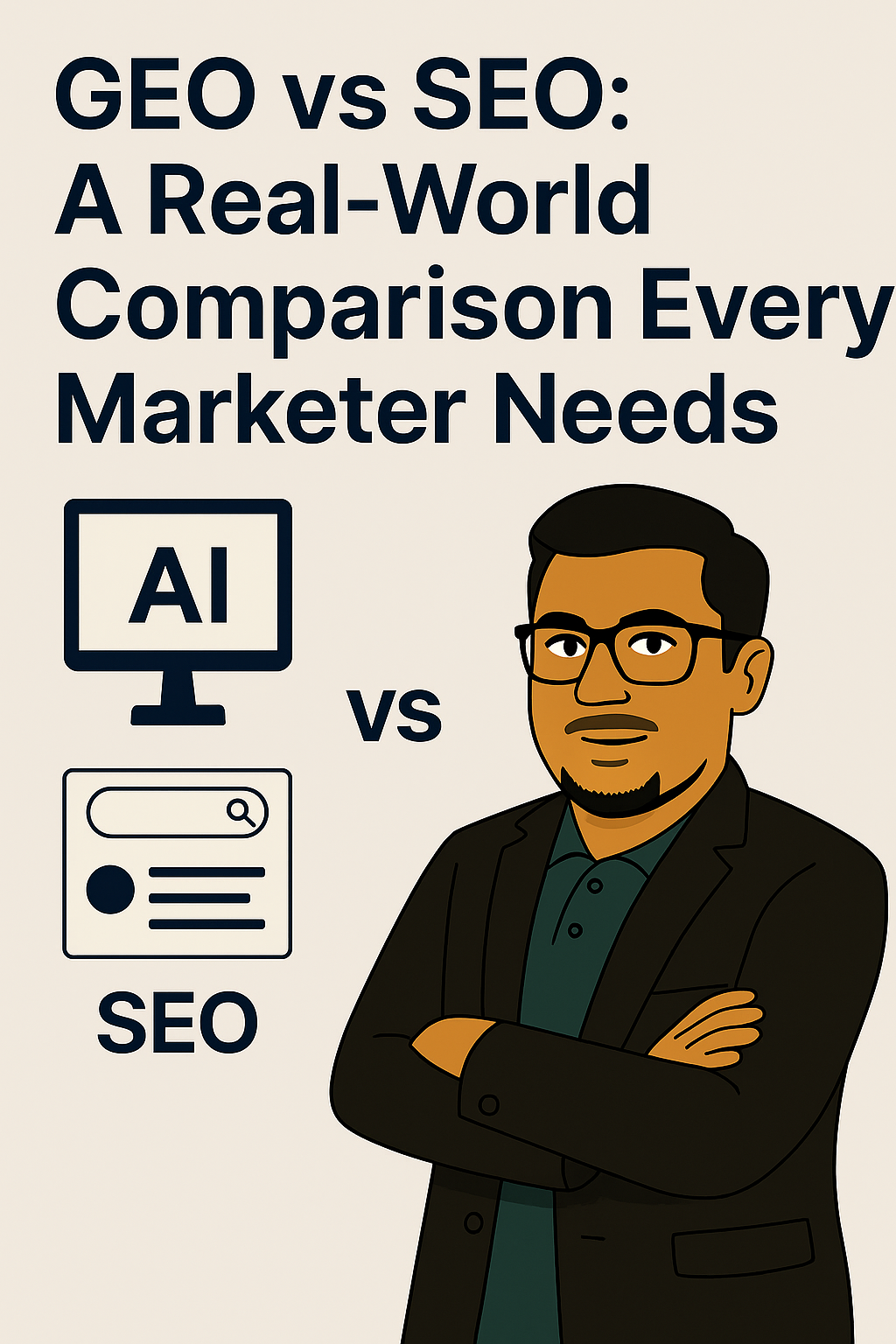
By Asif Ikbal Bhuiya – Global Marketing & Sales Tech Leader | Director @ RINGFEDER | GEO Practitioner

Once upon a time, digital marketing was all about ranking on Google.
We optimized for the search engine. We wrote content stuffed with keywords. And we checked our rank — every day.
But today? The rules are changing.
We’re no longer just writing for search engines. We’re writing to become the answer in an AI conversation. Welcome to the new paradigm: GEO vs. SEO.
Old SEO Mindset: Make Google Happy
In the past, I’ve worked with dozens of SEO plans where the priority was keyword placement — not necessarily clarity or real value for the reader.
Even my own team (back in the day) sometimes created content that ranked… but didn’t feel right. It wasn’t human. It wasn’t helpful. It was “SEO content.”
GEO Shift: Serve the Real Human Question
Now that I work on Generative Engine Optimization, the approach is flipped:
- First we identify what people are really asking.
- Then we create structured, easy-to-understand content.
- We focus on micro questions and answerable chunks — because that’s what tools like ChatGPT and Perplexity pull from.
GEO content is less about density, more about clarity.
How GEO and SEO Work in Different Ways
| Feature |
SEO |
GEO |
| Strategy Goal |
Rank in search engine |
Be selected in AI-generated answers |
| Content Structure |
Long-form, keyword-rich |
Short-form, answer-ready |
| Target Engine |
Google/Bing (classic) |
ChatGPT, Gemini, Perplexity |
| Optimization Focus |
Backlinks, keywords, meta |
Promptable structure, clarity, authority |
| Creation Priority |
Copywriters, content marketers |
Topic experts, thought leaders |
| Best Use Case |
Research-heavy, deep content |
Quick answers, Gen Z mindset |
Real-World Insight: SEO Still Has Power — But It’s Not Enough
We’re still in the early days of GEO. I’ve seen cases where:
- SEO wins when people are doing deep research on technical topics
- GEO wins when people need fast, confident answers
Especially in my industrial B2B field, where decision-makers still download whitepapers and specs, SEO is essential.
My Message to Marketers: GEO Is Not Optional
If you think SEO alone is enough, you’re falling behind. Here’s why:
- Gen Z and Gen Alpha are already asking AI tools for buying advice, career moves, and how-to guides.
- If your content doesn’t show up there, you’re invisible to a growing slice of your future audience.
GEO is not replacing SEO. GEO is making the top of the funnel wider.
GEO vs SEO: Practical Checklist
| ✅ Task |
SEO ✔ |
GEO ✔ |
| Is your content targeting a keyword? |
✔️ |
|
| Is your content answering a real question? |
|
✔️ |
| Did you structure using H2s and bullet points? |
✔️ |
✔️ |
| Do you include human clarity over density? |
|
✔️ |
| Is your content linked internally? |
✔️ |
✔️ |
| Have you tested it in ChatGPT or Bing? |
|
✔️ |
| Do you identify who the expert or author is? |
|
✔️ |
Before You Go…
Catch up on the full GEO introduction series:
Final Thought
In the end, SEO gets you discovered. GEO gets you remembered.
You don’t have to pick sides. You just have to evolve.
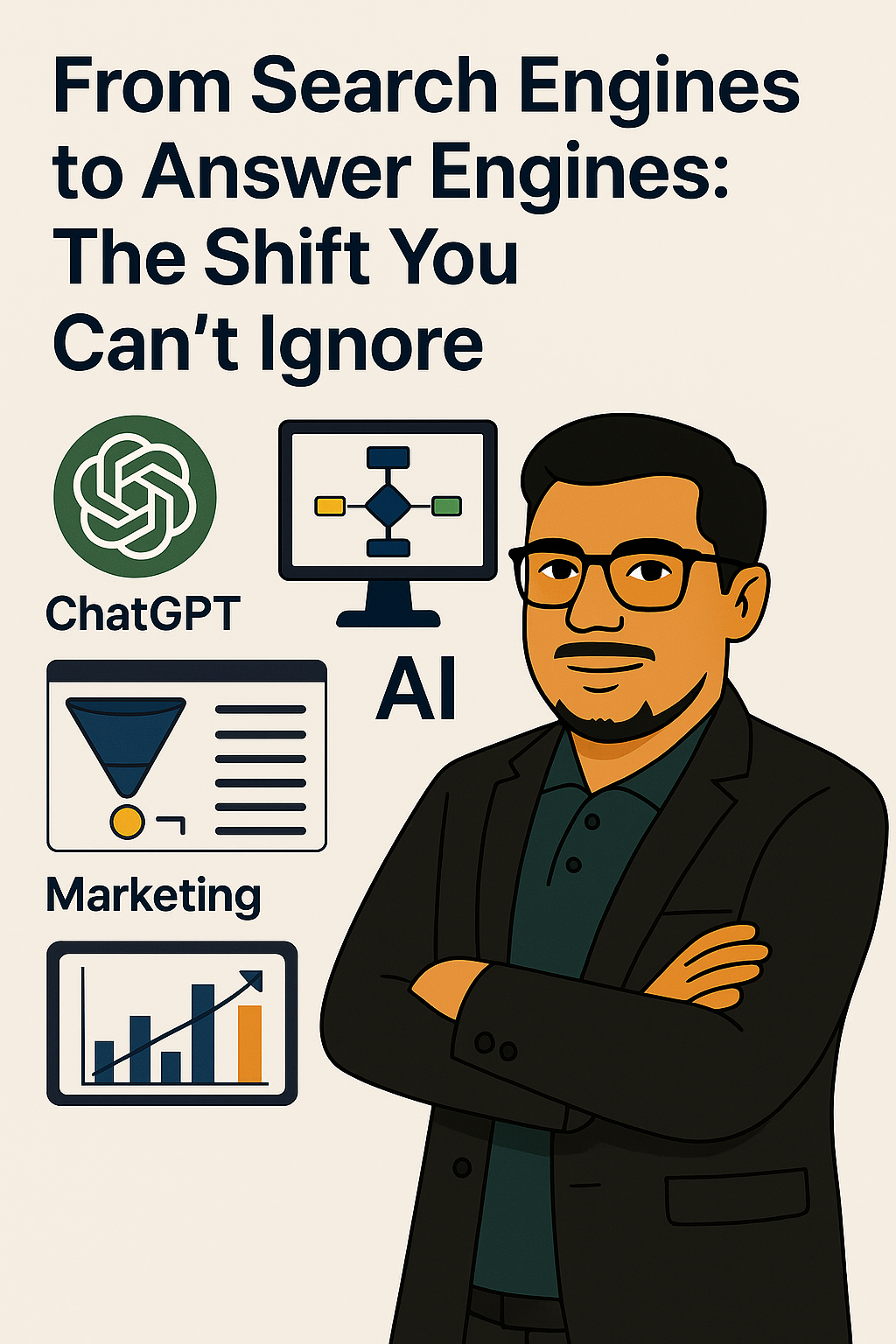
By Asif Ikbal Bhuiya – Global Marketing & Sales Tech Leader | Director @ RINGFEDER | B2B AI Explorer
I’ve been in digital marketing long enough to see trends come and go. But the shift we’re living through right now — from search engines to answer engines — isn’t a trend. It’s a complete change in how information works.
Search used to be a list of links. Now it’s just one answer.
And if your content isn’t that answer, you’re simply… out.
Let me show you why this matters, how I discovered the issue firsthand, and what every industrial marketer in Germany (and beyond) needs to start doing now.
🚦 I Used to Google. Now I Ask ChatGPT.
Like most marketers, I started testing generative AI tools early. I used ChatGPT, Bing Copilot, even Perplexity to see how they respond to marketing or product questions.
But what I found shocked me: Answers were partially wrong, sometimes completely off.
Why? Because our brand, RINGFEDER, serves a global audience — and different customer segments use our name in very different ways.
Our industrial couplings and trailer couplings (from a sister company) share the same brand name. Even the AI was confused — just like some of our customers. And that’s a problem.
It was the moment I realized: We need to train the AI ourselves.
That was the spark that led me to start our GEO project.
🧪 How I Found the Problem
I tested how AI answered questions about our product.
At first, it showed our distributor as the manufacturer. After several prompt variations, it finally gave the correct answer — RINGFEDER as the original source.
That inconsistency triggered a mindset shift:
“If AI can’t identify us right now, how can customers trust what it says next?”
I didn’t want our future customers, engineers, or partners to learn wrong things from a machine trained on low-quality content.
So I began optimizing for AI engines — not just Google. That’s GEO.
🧭 Search Engine vs. Answer Engine: The Core Difference
| Feature |
Search Engine |
Answer Engine |
| Output Format |
List of links |
One synthesized response |
| Ranking Signal |
Keywords, backlinks |
Context, clarity, authority |
| Visibility |
SERP (position) |
AI answer (selected source) |
| Outcome |
User clicks and scans |
User reads and moves on |
| Marketing Strategy |
SEO |
GEO |
📉 The Risk of One-Answer Systems
With Google, even if you were position 5, you got traffic.
With ChatGPT or Bing? There’s only one answer. If it’s wrong — or not yours — you’re done.
And yet, AI-generated content is flooding the internet. CVs, product reviews, guides — tons of them created in seconds.
But they lack:
- Accuracy
- Context
- Real brand input
That’s the gap I’m determined to fill — with correct, clear, and trusted content.
If someone asks ChatGPT about my products or company, they should get the right answer from the very beginning.
🏭 What German Industrial Brands Must Understand
Many companies are still deeply focused on SEO.
But here’s my message to German marketers:
“SEO won’t die. But it will get more complex for us — and simpler for our audience. Because SEO will become GEO.”
Your content must still rank — but now it must also be understood by machines, structured for retrieval, and wrapped in trust signals that LLMs recognize.
🛠 How You Can Start (GEO in Action)
You don’t need a big budget. Just start here:
- Test yourself: Ask AI questions about your brand. See what it gets right or wrong.
- Structure your content: Use Q&A formats, bullet points, and tables. Clarify ambiguous terms.
- Be present across AI-visible platforms: Blog, LinkedIn, YouTube, Medium — LLMs pull from them all.
- Lead with truth: AI amplifies what’s already published. Make sure your version is the one it learns from.
🚨 Final Thought: GEO Won’t Retire You — But Ignoring It Might
Here’s the wake-up call:
“GEO won’t give you early retirement. But it will decide whether your digital identity survives.”
If you’re a digital leader, start now. Even with small steps. Learn by doing. Test, adapt, structure, correct.
Because the robots are already talking. It’s your job to make sure they say the right things about you.
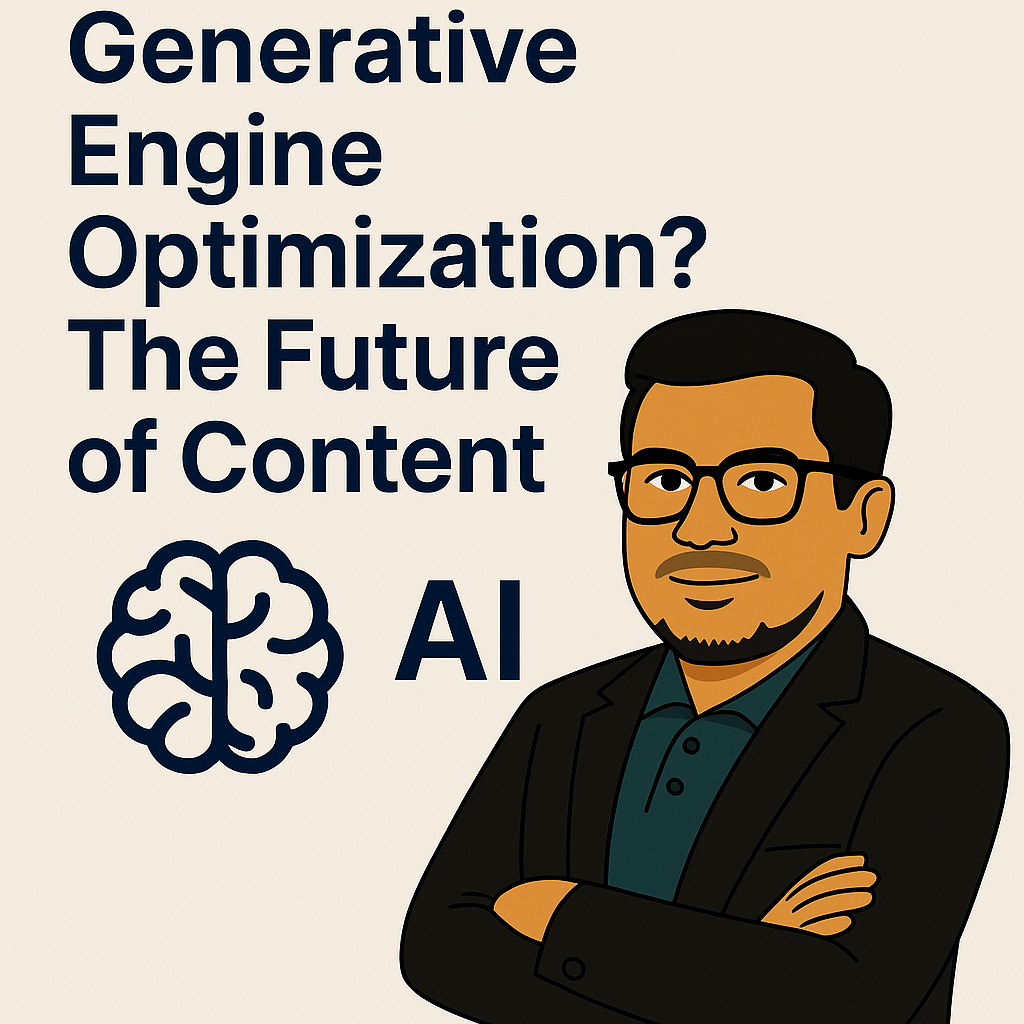
By Asif Ikbal Bhuiya – Global Marketing & Sales Tech Leader | Director @ RINGFEDER | AI-Driven B2B Strategist
In 2025, we’re no longer asking: “How do I rank on Google?”
We’re asking: “How do I become the answer selected by AI?”
That’s the core of Generative Engine Optimization (GEO) — a new discipline shaping the next phase of digital visibility.
As someone leading digital transformation in Germany’s industrial B2B sector, I’ve spent years optimizing for search engines. But now, I’m building strategies for something even bigger:
Visibility in AI-generated answers.
And I’m here to tell you: GEO is not a trend — it’s the future.
🔄 From Search Engines to Answer Engines
Traditional SEO is based on crawling, indexing, and ranking.
But tools like ChatGPT, Bing Copilot, Perplexity, and Gemini work differently:
- They don’t show a list of links.
- They generate a direct, synthesized answer.
- They rely on contextual embeddings, authority, and relevance.
In this system, there’s no “position 1”.
There’s only: 🟢 “Are you the chosen source, or not?”
🧠 What is GEO, Technically?
GEO (Generative Engine Optimization) is the process of:
- Structuring content to be retrievable and reusable by generative AI systems.
- Establishing digital authority and topical relevance across trusted sources.
- Embedding your brand, voice, and expertise into the “training diet” of modern AI.
Where SEO optimizes for indexing… GEO optimizes for answer synthesis.
It’s about becoming:
- LLM-prompt friendly
- Contextually aligned
- Structurally useful (via Q&A format, schema, tables, bullet logic)
- Credible enough to be surfaced without a backlink
🧪 Why I Know GEO Is Real (My Current Practice)
This is not theory. In my current role, I lead the global digital strategy for an industrial engineering brand trusted in 100+ countries.
Here’s what I’ve started doing:
- Asking customer-like questions in ChatGPT to see where we’re mentioned (or not).
- Testing how blog structures, metadata, or visuals affect visibility in tools like Perplexity.ai.
- Designing content workflows that combine SEO logic with AI retrievability.
- Documenting my findings in this public blog series — so others can learn what works.
I believe GEO is the new competitive edge — especially in B2B industries where trust, technical clarity, and relevance matter more than hype.
🏭 Why German Industry (and the World) Needs GEO Now
In Germany, I still see many B2B marketers:
- Overinvesting in Google rankings
- Undervaluing AI assistants like ChatGPT and Perplexity
At the same time, buyers and teams are already:
- Using ChatGPT for pitch prep
- Comparing products via Bing Copilot
- Expecting instant, confident answers instead of a list of blue links
This is the age of zero-click, AI-first discovery. GEO is your way into that pipeline.
💡 The Key Elements of GEO
Let’s break it down:
| Concept |
SEO |
GEO |
| Engine Type |
Crawler-based |
AI model-based |
| Goal |
Rank in search results |
Be used in answers |
| Structure |
HTML, meta tags |
Semantic clarity, Q&A, promptability |
| Signals |
Backlinks, speed |
Authority, context, structure |
| Visibility |
User click |
AI output (zero-click) |
| Main Tool |
Google |
ChatGPT, Gemini, Bing, Perplexity |
To win at GEO, you need to:
- Understand how LLMs process and recall information
- Create content that fits the shape of a good answer
- Tie your name, brand, and topics together in structured, trustable formats
🚀 Why GEO Will Outlive SEO
Here’s the honest truth:
SEO is still alive — but it’s no longer the only game in town.
Modern AI systems don’t care about your keyword density.
They care about:
- Clarity
- Structure
- Authority in topic clusters
- Cross-platform consistency (LinkedIn, blog, YouTube, etc.)
GEO isn’t replacing SEO. It’s extending it into a new era where:
- You train the engines by how you write
- You get selected because you’re understood, not just optimized
- Your digital reputation becomes your most important ranking factor
🧭 Final Thought: The Time to Act Is Now
You don’t need to be a developer or prompt engineer to do this.
You just need to:
- Understand how AI engines choose content
- Adapt your structure, voice, and topics
- Stay consistent across your platforms
- Lead with authentic expertise, not trendy content
In the next post, we’ll dive into how generative engines like ChatGPT and Gemini actually work — and how to reverse-engineer their logic to increase your chances of being cited, surfaced, or paraphrased.
Because in this new world, you’re either the answer… or you’re invisible.
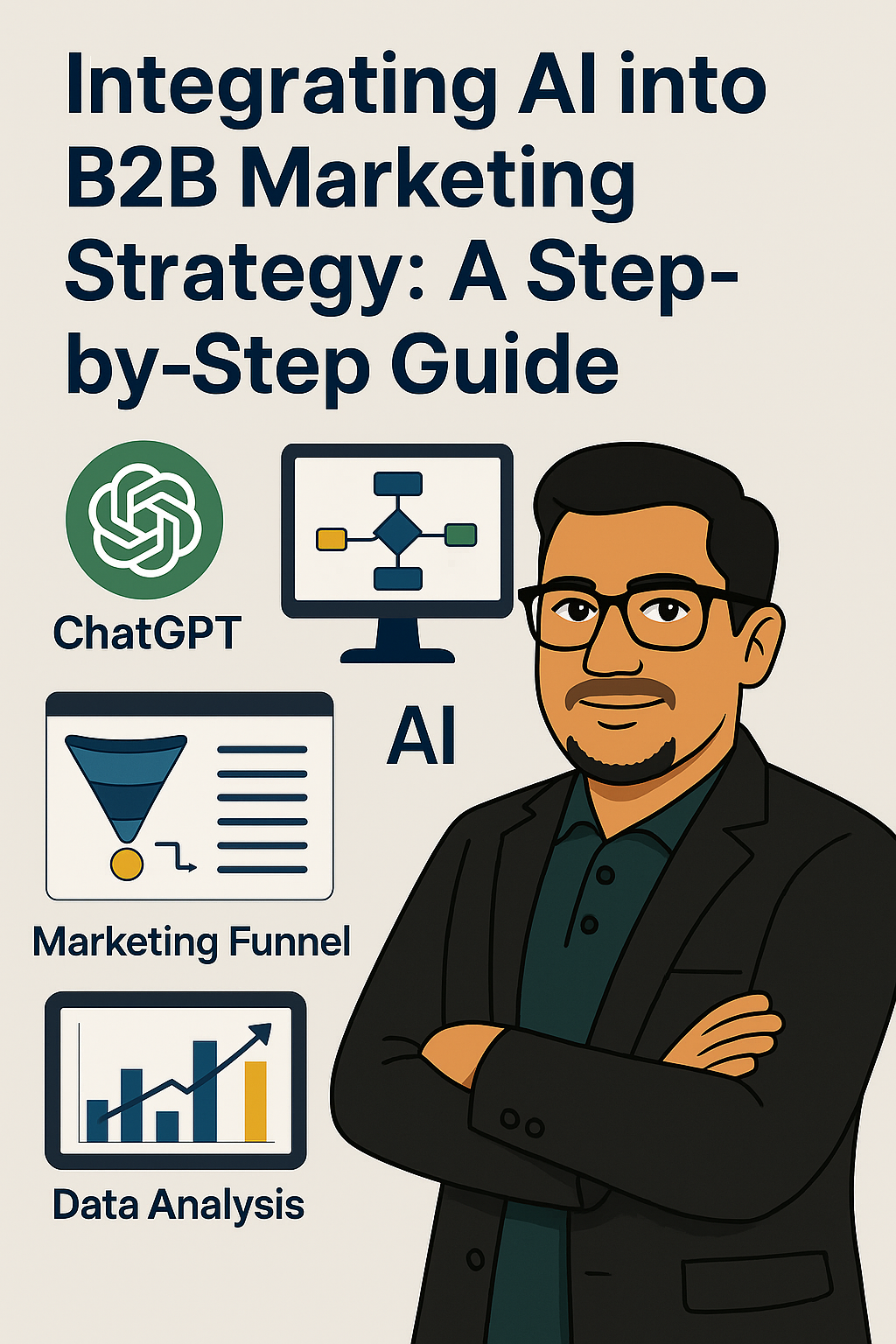
By Asif Ikbal Bhuiya
In B2B marketing, there’s a lot to follow: long sales cycles, complex buying journeys, and region-specific regulations. For me, AI isn’t just about writing content or chasing trends — it’s about staying on track, making better decisions, and staying aligned with sales.
AI helps my team summarize the past, analyze the present, and act smarter for the future — especially when the funnel has many steps and stakeholders. Here’s exactly how we do it.
🧠 What AI in B2B Marketing Means to Me
I see AI as a support agent — not the creative, not the strategist, but the one who keeps us focused.
In our daily operations, AI helps us:
- Track and summarize customer journeys
- Generate structured content and campaign ideas
- Automate nurturing flows
- Align more closely with sales by sharing context
- Follow up faster — with relevance
It’s not about replacing our voice — it’s about making sure we don’t lose it in the noise.
🎯 Where We Use AI Across the Funnel
We don’t just use AI at the “top” of the funnel — it supports us at every step, like a silent team member.
1. Awareness
We use ChatGPT to build content outlines and repurpose ideas. It’s like a strategic assistant that never sleeps.
2. Engagement
Email subject lines, social captions, visual prompts — all AI-assisted. Not to replace human creativity, but to test faster and reach the audience sooner.
3. Lead Nurturing
This is where HubSpot AI shines. Smart workflows, automated follow-ups, and persona-based triggers help us move faster — and more personally.
4. Conversion & Handover
Our leads don’t just stay in marketing. When we qualify them, we pass them to sales — and our Caesar CRM keeps them aligned with ERP and real pipeline processes.
5. Feedback Loop
We use Looker Studio and Matomo for campaign performance. Matomo gives us cookie-less insights, and Looker lets us see the full journey clearly.
🧰 AI Tools We Use (And How)
We didn’t adopt every tool on Day 1 — but here’s what our team uses today:
✅ HubSpot AI
Everyone on the team is HubSpot-proficient. AI helps us:
- Suggest workflow improvements
- Discover insights on contact activity
- Optimize reports
- Plan smarter nurture flows
✅ ChatGPT
Our content assistant. It helps:
- Organize thoughts
- Restructure long-form blogs
- Repurpose ideas into new formats
- Maintain alignment with buyer personas
✅ Microsoft Copilot
Because our company approved it, we use it for:
- Secure work: emails, PowerPoints, and internal summaries
- Fast internal documentation
- Structuring sensitive strategic content
✅ Looker Studio & Matomo
We believe in dual tracking.
- Looker → visualizes customer journey data
- Matomo → cookie-less tracking that’s GDPR-safe and reliable
⚠️ The Challenges We Faced
We didn’t go from zero to AI overnight. There were bumps:
- Mindset resistance: “Will it replace my job?” — We had to reframe it.
- GDPR worries: We made sure AI doesn’t mean careless data handling.
- Too fast, too soon: Some people wanted 10 workflows in week 1. It took leadership to slow things down.
Today, we’re confident — but we’re still evolving.
🧭 Final Thought: Start Small. Stay Human.
AI is not magic — but it is powerful when applied right.
You don’t have to automate everything.
You just need to know what not to automate.
My advice?
🔹 Start small.
🔹 Build your own use case library.
🔹 And stay focused on strategy — because AI still needs leadership.
📩 Want help mapping or modernizing your stack?
You can:
📚 Want more insights like this? Explore my full blog archive for more practical strategy tips.
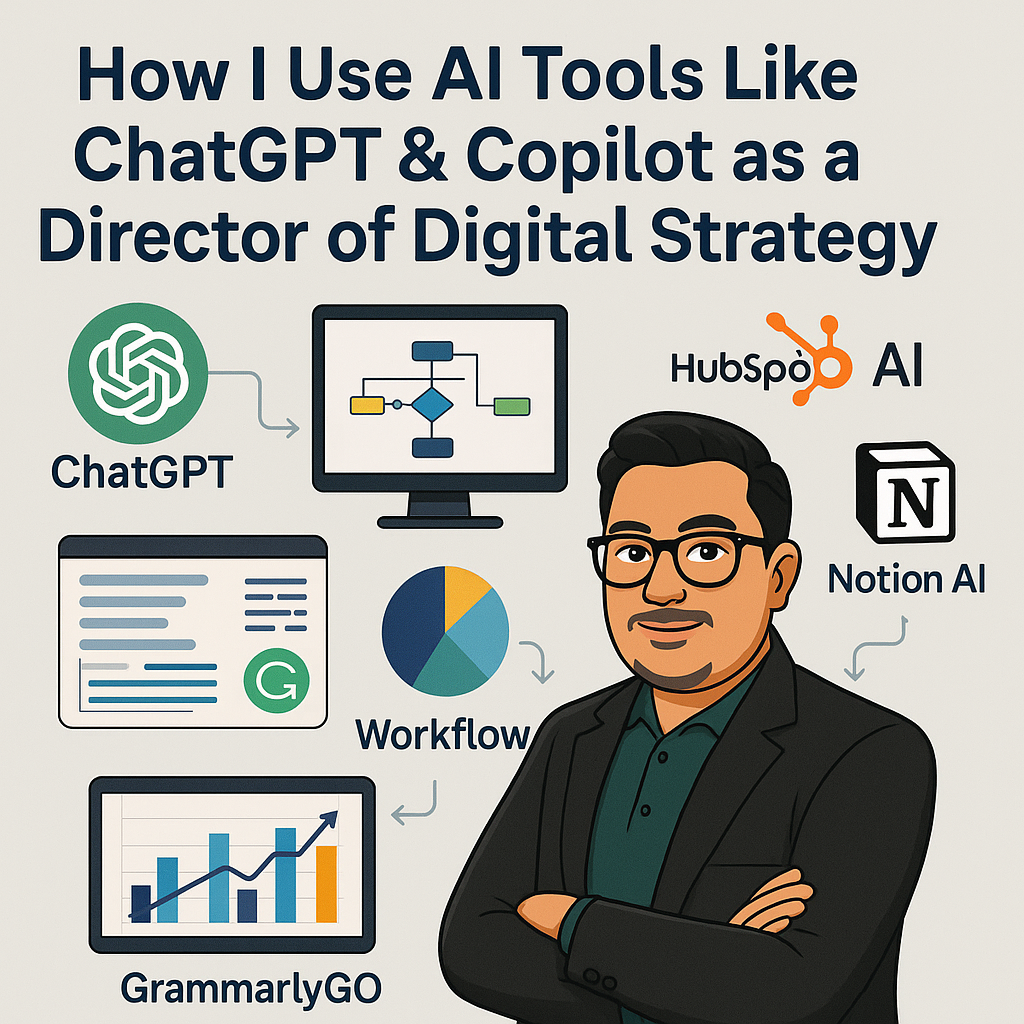
By Asif Ikbal Bhuiya
Let’s face it: most people still think of AI as either a futuristic robot or a flashy writing gimmick.
But for me — and for many digital leaders in real companies — AI is something more practical:
🧠 A smart co-worker
🛠 A productivity amplifier
📊 A pattern recognizer that helps ideas grow
As someone leading global digital marketing and sales technology, I don’t use AI to replace human work.
I use it to refine it, scale it, and make it smarter.
Let me show you how.
🔍 First — The Tools I Actually Use
I’ve tested dozens of platforms, but these are the ones in my real weekly workflow:
- ChatGPT → For campaign thinking, content drafts, and report structuring
- Microsoft Copilot (365) → For summarizing large docs, presentations, Excel sheets
- HubSpot AI → For subject line suggestions, contact insights, lead scoring
- Notion AI → To improve clarity of team notes and project outlines
- GrammarlyGO → To elevate tone and fix awkward sentences
- Bard & Grok (for testing) → For cross-checking perspectives and creative inspiration
Each has its own rhythm. The trick is not choosing “one AI to rule them all.”
The trick is knowing when to reach for which one.
💼 Where AI Actually Helps in My Role
I don’t “automate everything.” I stay human — but sharper.
✅ 1. Summarizing Long Reports
Whether it’s a product spec sheet, a global market update, or a campaign analysis — I use Copilot or ChatGPT to get clear, structured summaries.
Then I shape the story based on what matters to my business audience.
✅ 2. Planning Campaign Ideas
I don’t ask AI to create campaigns.
I bring the context — and then use ChatGPT to stress-test my ideas, refine positioning, or simulate objections.
It’s like brainstorming with a very fast, always-on strategist.
✅ 3. Improving Messaging & Tone
Whether it’s internal slides, external emails, or a leadership post, I run drafts through GrammarlyGO or ChatGPT to refine structure and tone.
Sometimes I just ask, “Is this too formal?”
Turns out — AI can be a surprisingly good editor.
✅ 4. Team Enablement & Knowledge Transfer
When onboarding new team members or sharing cross-country insights, I use Notion AI to simplify complex process notes into more digestible explanations.
✅ 5. Content Planning with Confidence
I combine keyword research with ChatGPT suggestions to build outlines. Then I validate everything with real user behavior and internal data.
AI gives me speed. But strategy still needs the steering wheel.
⚖️ So… Which Tool Is Best?
Honestly? That’s like asking which is better — a screwdriver or a hammer.
- Copilot is great inside Microsoft Office.
- ChatGPT is the best for creativity + idea generation.
- HubSpot AI wins in marketing context and contact insights.
- GrammarlyGO helps polish tone fast.
- Bard & Grok? Still evolving — good for perspective checks.
Here’s what I tell others:
💡 “Try them all. Use what works. Discard what doesn’t. AI adoption is not about mastering tools — it’s about improving systems.”
🤔 Final Thought
I don’t use AI to replace thinking.
I use it to focus it.
AI helps me get to the signal faster. It clears the noise in long reports, shaky drafts, or uncertain plans.
And most importantly:
It gives me back time — so I can think bigger.
So if you’re a professional worried AI will replace you — don’t be.
Instead, use it to amplify what makes you human.
📩 Want help mapping or modernizing your stack?
You can:
📚 Want more insights like this? Explore my full blog archive for more practical strategy tips.
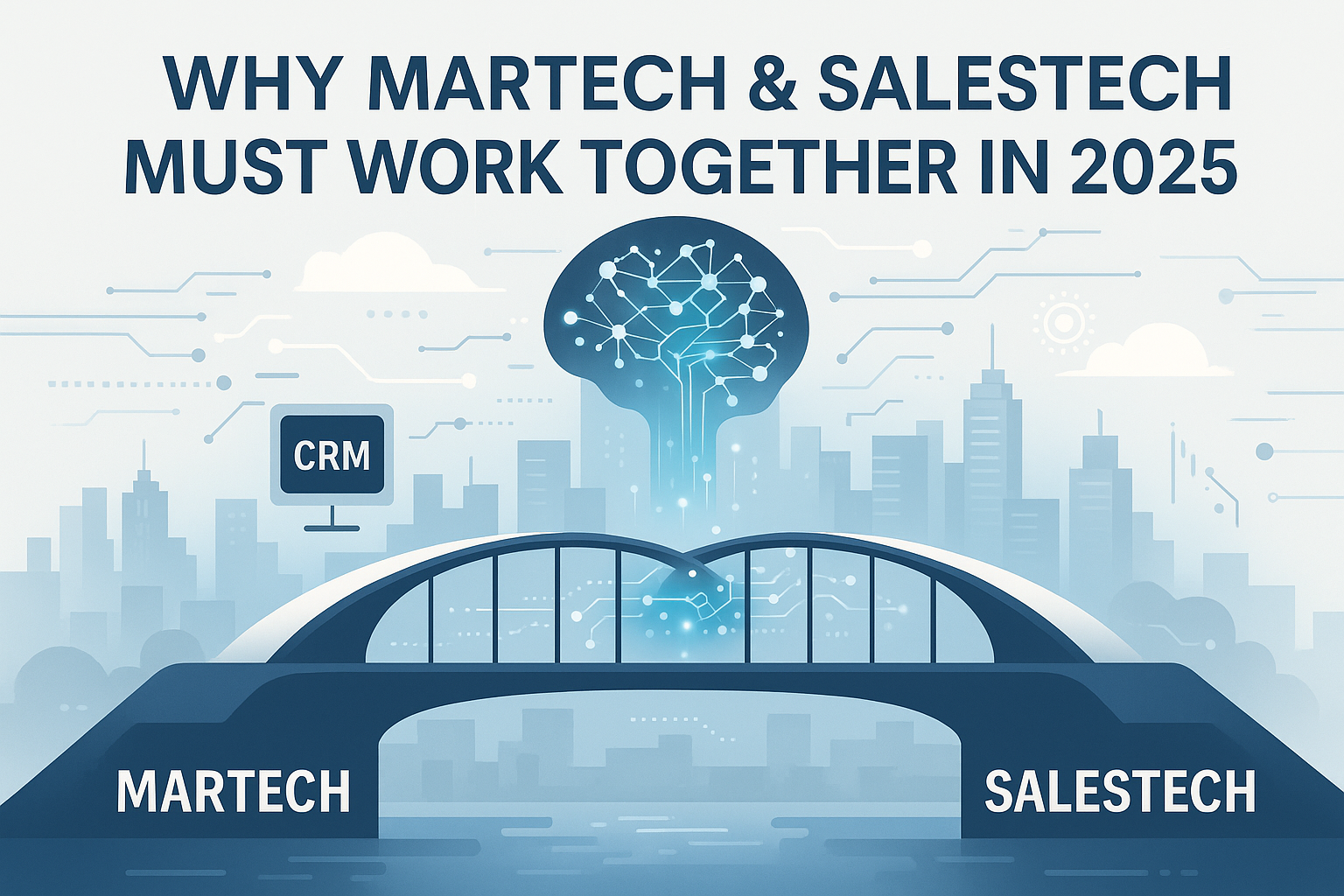
By Asif Ikbal Bhuiya
You know the feeling: marketing works hard to attract leads, sales follows up (sometimes), and in the end, no one really knows what happened to half of them.
In fast-moving tech companies, maybe you can afford a few broken systems. But in industrial B2B — especially in Europe — where buying decisions take months, product selection is long-term, and data privacy is strict, that kind of gap can quietly kill growth.
So let’s talk about something I’ve seen over and over:
👉 Why your MarTech and SalesTech systems absolutely must speak the same language in 2025.
🧩 What Happens When They Don’t?
From my global experience working across regions and industries, the pain points tend to repeat:
- A marketing lead looks hot in your inbound CRM but never makes it to the sales system.
- Sales closes a long-nurtured deal and marketing never knows — the win never gets credited or analyzed.
- A buyer gets invited to a trade fair from one system, then emailed a survey from another — both unaware of each other.
- You generate quality leads via blogs, webinars, or whitepapers — but later, due to privacy rules or disconnected systems, you can’t even tell if that lead ever became a customer.
It’s not just a tech problem. It’s a data trust problem. A customer experience problem. A long-term revenue leak.
🔄 What Working Together Looks Like (In Real B2B Life)
In one of my current global B2B roles (let’s keep names aside), we use a hybrid of marketing automation (for inbound + fairs) and a CRM connected to ERP for real buyer handling.
Here’s how it works — or sometimes struggles to work:
- Marketing captures a lead via content or QR scan at an event.
- That lead lives inside our inbound system — scored, nurtured, and tagged.
- When the lead becomes “sales-ready,” we hand it to the sales team.
- BUT: if systems aren’t tightly synced, sales may never see it.
- And even when they do, if the CRM isn’t linked back to marketing tools, we don’t know if they converted.
It’s not about blame.
It’s about visibility.
It’s about connecting the dots.
📈 Why 2025 Is the Year of System Unity
✅ AI Is Here (and It Needs Clean Data)
AI tools like Copilot, ChatGPT, and custom dashboards are only as smart as the data they can access. If your MarTech and SalesTech are split, your AI is flying blind.
✅ B2B Buyers Expect a Smooth Ride
Even in engineering-heavy industries, decision-makers now expect B2C-like consistency. They don’t care about your backend — they want timely replies, personalized info, and no repetition.
✅ Privacy Rules Aren’t Going Away
GDPR and industry-specific compliance will keep making things harder. If your lead path isn’t clear, your ability to track ROI and conversions becomes legally murky.
💡 What You Can Do Now
- Audit your lead flow: where marketing ends and sales begins
- Map the systems (is the CRM picking up what the inbound tool is capturing?)
- Create shared goals: not “leads vs. revenue” but “pipeline impact”
- Start small: even a shared contact field or aligned workflow is progress
If you’re exploring how to improve your digital marketing systems, learn more about my approach as a digital marketing expert in Germany.
🎯 Final Thought
You don’t need to unify everything overnight.
But in 2025, if your MarTech and SalesTech don’t work together — you’ll lose leads, miss insights, and frustrate your future customers before they even get a chance to meet you.
Let your systems talk. Let your teams align.
And you’ll see marketing and sales do what they were always meant to do — win together.
📩 Want help mapping or modernizing your stack?
You can:
📚 Want more insights like this? Explore my full blog archive for more practical strategy tips.
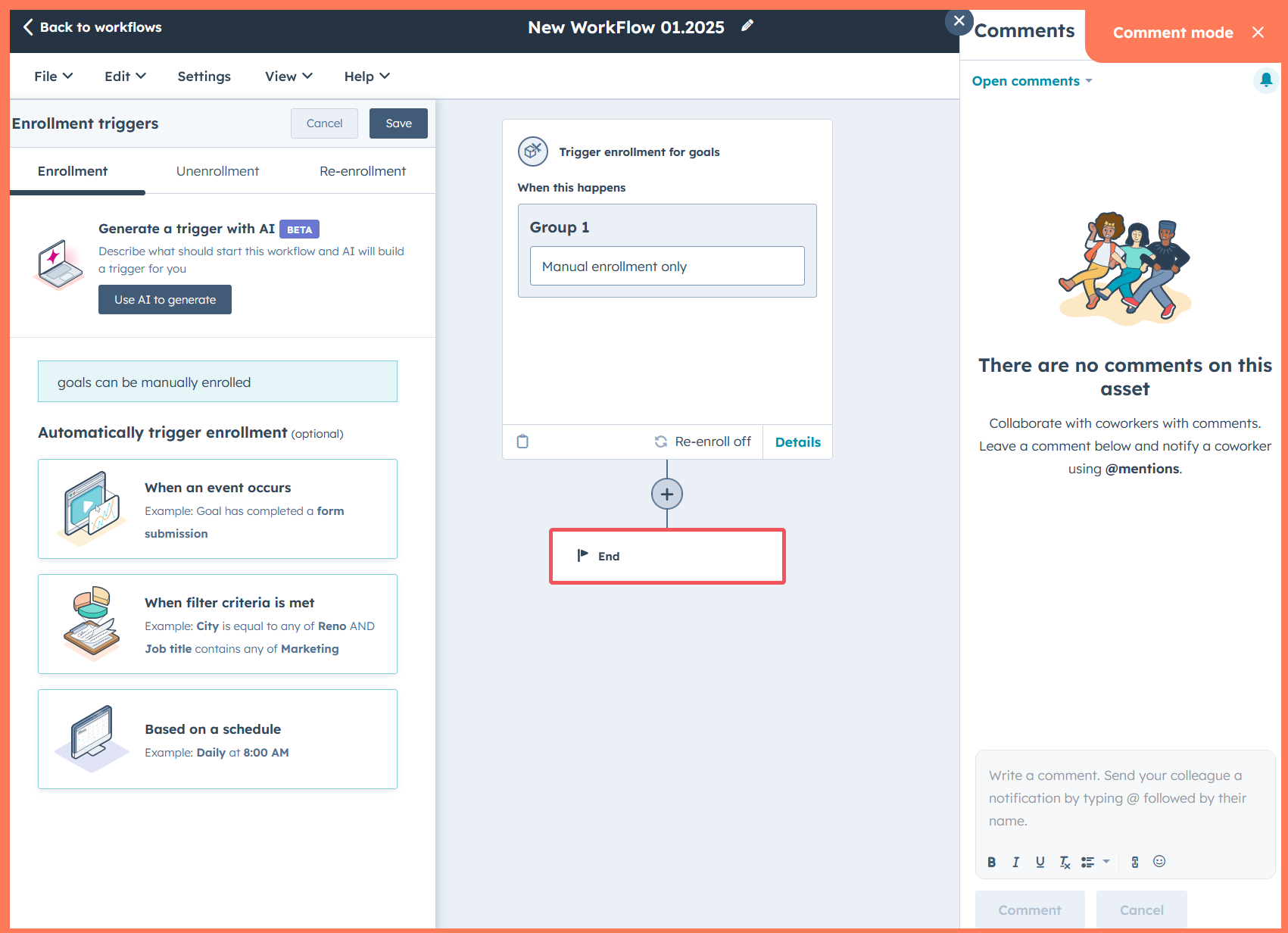
🚀 1. Build Your Own Data Hub: Smarter Decisions with AI
AI is only as good as the data you feed it. Create a centralized data hub to store past performance and real-time trends. This will empower your business to make smarter, data-driven decisions.
Question: Is your business ready to leverage data for smarter AI-driven decisions?
💡 2. From Planning to Action: Empower Teams with Low-Code Tools
With tools like HubSpot and Episerver (Optimizely), you don’t need an IT department to innovate. Low-code platforms empower your team to execute and automate quickly, transforming plans into action.
Question: Are you using tools that help your team act, not just plan?
📊 3. Real-Time Insights: IoT and Edge Computing for Smarter Decisions
Monitor your business in real-time with IoT and edge computing. This data-driven approach enables faster decision-making and smoother operations
Question: How are you using real-time data to make faster, smarter decisions?
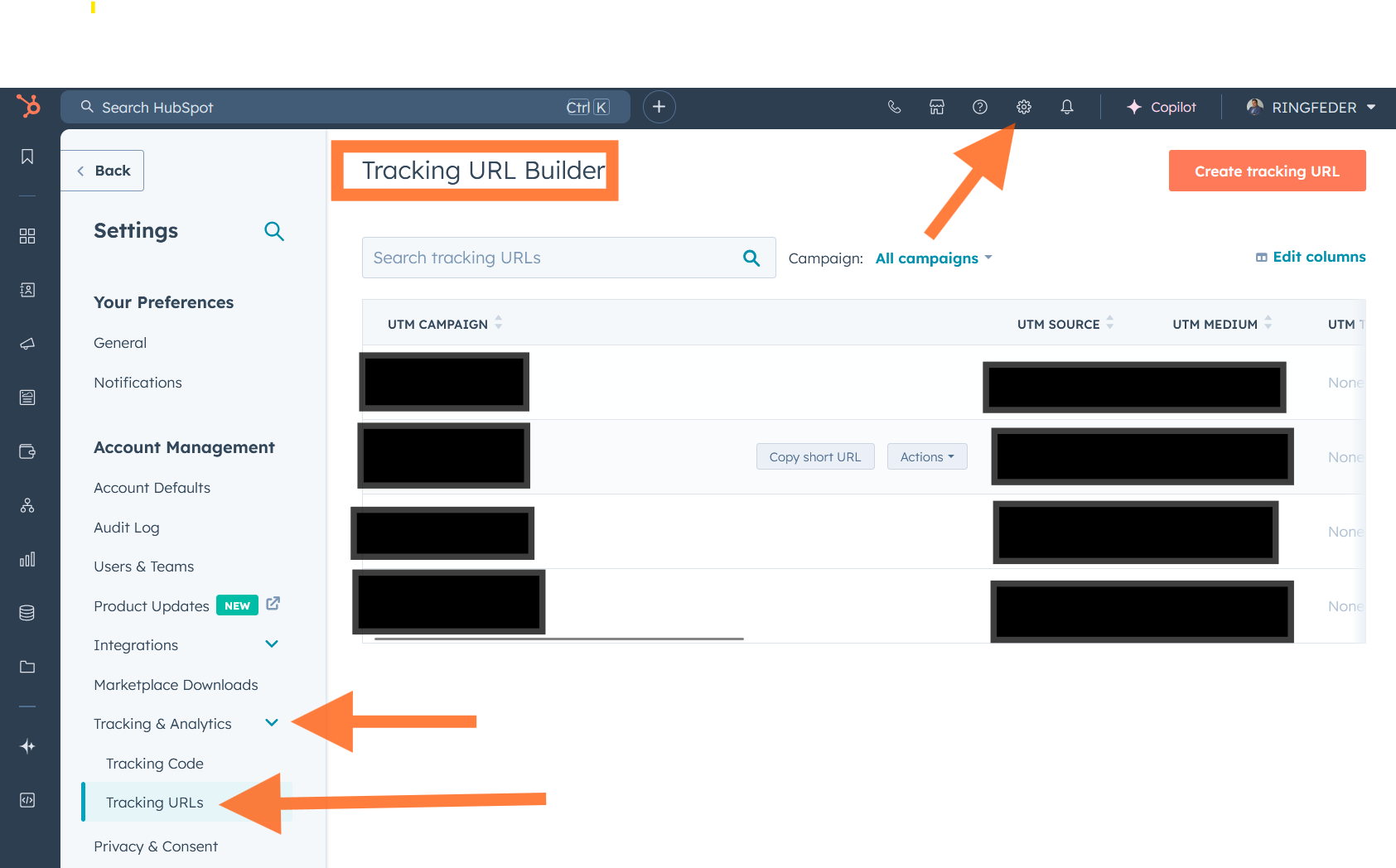
Data-driven marketing isn’t just my strategy—it’s my obsession. But let’s be honest: without tools like HubSpot’s Tracking URLs, making sense of campaign performance would feel like throwing darts in the dark.
Here’s how I’ve used Tracking URLs to turn confusion into clarity:
1️⃣ Why I Use Tracking URLs
Because guessing doesn’t cut it! HubSpot lets me add UTM parameters to links so I can finally answer, “Where are these clicks coming from?” (Spoiler: It’s usually not the email I thought would work.)
2️⃣ How I Make It Work
- Channel Testing: One link for email, another for social, and voilà—I know which audience loves me most.
- Real-Time Tweaks: HubSpot analytics show me what’s converting now, so I can tweak campaigns while they’re live.
- Actionable Data: Turns out, “gut feelings” don’t pay the bills—data does.
3️⃣ Wait… Is This GDPR-Compliant?
Good news: It is! 🎉 As long as you’re not tracking personal data (e.g., without consent), and you’re transparent about tracking practices, you’re playing by the EU’s rules. Tracking URLs themselves don’t process personal data—they just tell me which link brought traffic. (Big relief, right?)
The Result?
Better campaign ROI, fewer surprises, and more confidence in my data-driven decisions. Who knew tracking URLs could make life this much easier?
➡️ My question to you: Are you using tools like HubSpot to their full potential? Or are you still playing the guessing game? Let’s talk in the comments!
Tired of feeling like just another face in the crowd? Say hello to hyper-individualized marketing – your ticket to a personalized experience like no other, powered by the magic of AI (that’s Artificial Intelligence)!
Gone are the days of generic emails that barely catch your eye. With hyper-individualized marketing, it’s all about YOU. Here’s how it works:

Getting to Know You Better: Imagine if a marketing genie could peek into your online world, understanding not just what you buy but what makes you tick. That’s what AI does! It looks at your digital footprints – from the websites you visit to the stuff you talk about on social media – to figure out what makes you, well, you.
Mind-Reading Powers: Okay, not really, but it’s close! AI analyzes all that juicy data to predict what you might want next. It’s like having a friend who knows you so well they can finish your sentences – except this friend is a super-smart computer.
Instant Tailoring, Just for You: Ever wished a website could read your mind? With AI, it’s almost like that! Websites, emails, and even social media posts can change in real time to match what you’re interested in. It’s like having a personal shopper who knows your style perfectly.
But hey, with great AI power comes great responsibility:
Privacy First: Your data is precious, and it’s important to keep it safe. Ethical AI means being transparent about how your info is used and always putting your privacy first.
So, what’s in it for you?
Feel Seen, Feel Heard: No more being lost in the crowd! Hyper-individualized marketing makes you feel like the star of the show.
Discover New Faves: Ever had that “wow, they just get me” moment? That’s what happens when AI suggests something you didn’t even know you wanted – but turns out, you love it!
Happier Shopping: Imagine finding exactly what you need, exactly when you need it. With hyper-individualized marketing, shopping becomes a breeze.
So, are you ready to dive into the future of marketing? Let’s chat about how AI can make your online world feel tailor-made, just for you! 🚀
Welcome to the ever-evolving universe of SEO, where the rules are written in code, and the algorithms dance to a dynamic beat. As we enter 2024, the landscape buzzes with excitement and transformation. Here’s your guide to surfing the waves of change and conquering the SEO realm:

1. Farewell, Third-Party Cookies: Google’s Grand Exit
Bid farewell to third-party cookies as Google takes a bold step towards user privacy. By the end of 2024, Chrome will no longer indulge in the cookie jar. What does this mean for SEO specialists? Brace yourselves for a shift to first-party data – your website’s new best friend. It’s time to cosy up to user engagement metrics and embrace the era of personalized, privacy-conscious strategies.
2. Google’s SGE: Searching Beyond the Horizon
Google’s Search Generative Experience (SGE) is not just a feature; it’s a journey. Prepare for an expedition into personalized and interactive search results. Command your searches, revel in summaries, videos, and more. SEO trailblazers, ensure your websites are SGE-ready – because, in 2024, the search experience is not just about finding; it’s about interacting.
3. UX: The Crown Jewel of SEO Kingdoms
In the SEO monarchy, user experience wears the crown. Google’s unyielding love for seamless journeys, lightning-fast loading speeds, and mobile-friendly realms continues. Don’t just meet expectations; exceed them. Elevate your UX game, and watch your SEO kingdom rise through the ranks.
4. The Rise of AI: Co-Creators of Content Symphony
AI-powered maestros now conduct the symphony of content creation. Writing assistants fueled by artificial intelligence are stealing the limelight. But here’s the twist – don’t sideline human creativity. Let AI be your sidekick, not the protagonist. In 2024, the best content is a harmonious blend of machine efficiency and human finesse.
5. Spam Wars: A Battle for Quality Content
The battlefield against low-quality content rages on. Google sharpens its swords to detect and defeat spammy intruders. The key to victory? Originality, value, and relevance. Arm yourself with informative content that not only survives but thrives in the ever-watchful eyes of search engines.
6. Local SEO: Navigating the Streets of Visibility
For brick-and-mortar warriors, the battleground is local. Google Business Profiles are your armour, local backlinks are your weapons, and community engagement is your strategy. Secure your place on the local SEO map and attract customers from every street corner.
7. Algorithms: Dance Partners in the SEO Ballroom
In the SEO ballroom, algorithms are your dance partners. Google constantly refines its moves, and you must keep pace. Stay alert, adapt your steps, and monitor the rhythm of website traffic, keyword rankings, and backlink profiles. In 2024, it’s not just about the dance; it’s about mastering the ever-changing choreography.
Conclusion: Sailing into SEO Victory in 2024
As we bid farewell to the old and embrace the new, remember – SEO in 2024 is a thrilling expedition, not a mundane journey. Prioritize user-centricity, harness the power of AI wisely, and dance with the algorithms. In this dynamic SEO galaxy, those who adapt, innovate, and conquer will emerge as the true champions of the digital frontier. Gear up, SEO enthusiasts – the adventure awaits!









